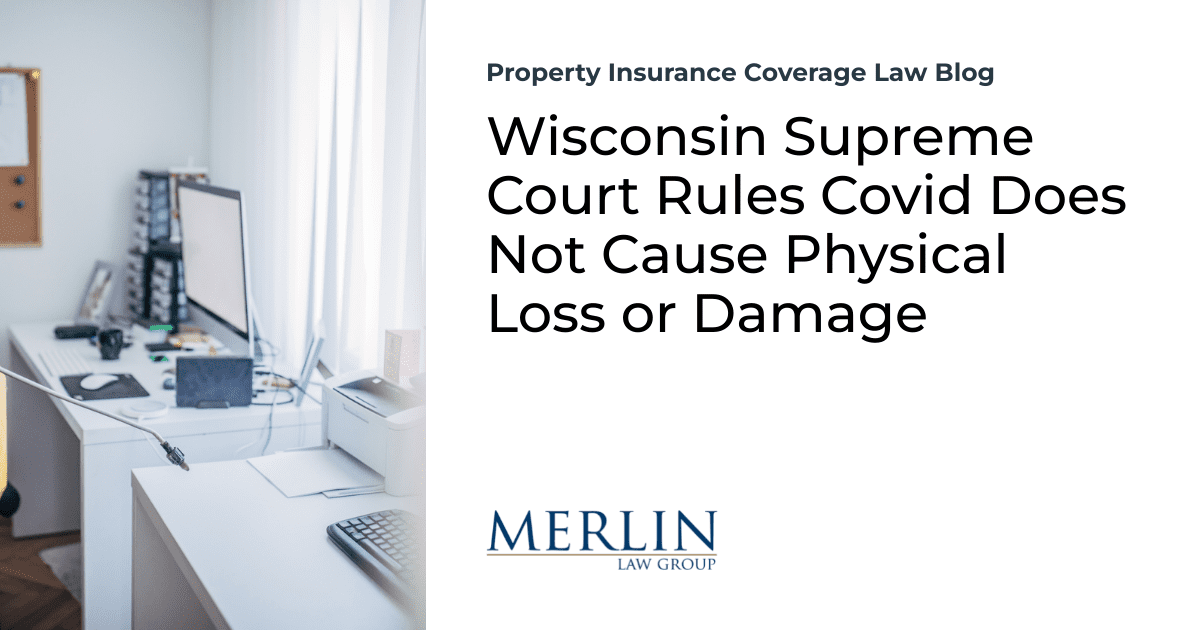Wisconsin Supreme Court Rules Covid Does Not Cause Physical Loss or Damage

While I was reading a Wisconsin Supreme Court decision cited in my post, Is Bat Infestation and Damage Covered Under A Homeowners Policy?, I noted that the same court held Covid 19 does not make property suffer physical loss or damage.1
The primary reasoning was as follows:
The provisions of Society’s policy on which Colectivo relies, with the exception of the contamination provision, all require Colectivo to allege a direct physical loss of or damage to either its property or a surrounding property. Although Society’s policy does not define ‘direct physical loss of or damage to’ property, our prior cases interpreting similar language establish that physical losses and physical damages refer to different degrees of tangible harm. An insured suffers a physical ‘loss’ of its property when the property is ‘destroyed’ or affected to such an extent that it cannot be repaired. See RTE Corp. v. Md. Cas. Co., 74 Wis. 2d 614, 624, 247 N.W.2d 171 (1976). Such a loss occurs, for example, when a building burns down and must be rebuilt. See, e.g., Park Terrace, LLC v. Transp. Ins. Co., No. 2010AP2432, unpublished op., ¶4 (Wis. Ct. App. Dec. 1, 2011). Physical ‘damage’ is harm to the tangible characteristics of the insured property that does not rise to the level of a physical loss. See Wis. Label Corp. v. Northbrook Prop. & Cas. Ins. Co., 2000 WI 26, ¶¶29–31, 233 Wis. 2d 314, 607 N.W.2d 276; see also Sandy Point Dental, PC v. Cincinnati Ins. Co., 20 F.4th 327, 332 (7th Cir. 2021). So a roof that is dented by hail but remains functional has incurred physical damage because ‘[t]his denting changes [its] physical characteristics.’ Advance Cable Co., LLC v. Cincinnati Ins. Co., 788 F.3d 743, 747 (7th Cir. 2015). By contrast, a product that is merely mislabeled has suffered no physical damage because its tangible characteristics are unchanged. See Wis. Label Corp., 233 Wis. 2d 314, ¶¶31–33.
…
As the overwhelming majority of the other courts that have addressed the same issue have concluded, the presence of COVID-19 does not constitute a physical loss of or damage to property because it does not ‘alter the appearance, shape, color, structure, or other material dimension of the property.’ See, e.g., Sandy Point Dental PC v. Cincinnati Ins. Co., 488 F. Supp. 3d 690, 693–94 (N.D. Ill. 2020) (collecting cases), aff’d, 20 F.4th 327 (7th Cir. 2021). The virus does not necessitate structural ‘repairs or remediation’; it can be removed from a surface with a disinfectant. See Uncork & Create LLC v. Cincinnati Ins. Co., 498 F. Supp. 3d 878, 883–84 (S.D. W. Va. 2020), aff’d, 27 F.4th 926 (4th Cir. 2022). Likewise, COVID-19 does not render property ‘inherently dangerous’ or ‘uninhabitable’ in the same way as ‘ongoing rockfalls’ or wildfire smoke might, because COVID-19 is not a ‘physical peril that makes merely entering a structure hazardous.’ See Biltrite Furniture, Inc. v. Ohio Sec. Ins. Co., No. 20-CV-656-JPS-JPS, 2021 WL 3056191, at *4 n.4 (E.D. Wis. July 20, 2021). Rather, the danger of the virus is to ‘people in close proximity to one another,’ not to the real property itself. Id.; see also Uncork & Create, 498 F. Supp. 3d at 884.
As for Palm’s orders, although they restricted Colectivo’s use of its property, Society’s policy makes clear that a loss of use is distinct from physical loss of or damage to property. For instance, in a provision regarding personal property, the policy expressly covers damages for both the loss of or damage to that property as well as the loss of the use of that property: ‘We [Society] will pay . . . damages because of direct physical loss or damage, including loss of use, to [invitees’ personal property] caused by accident and arising out of any covered cause of loss.’ By contrast, the policy provisions on which Colectivo relies omit any loss-of-use language, instead covering only a ‘direct physical loss of or damage to’ the property. One may think of the business-income provision as indirect loss-of-use coverage, but that does not change the fact that a prerequisite for that provision is still a direct physical loss or damage. ‘Loss of use’ is thus distinct from a ‘direct physical loss or damage,’ and Colectivo’s argument fails because it conflates the two.
As indicated in a brief I filed in the Erie Insurance Federal Multidistrict Litigation, I simply disagree with this reasoning. I think it fundamentally changes what “physical loss” has meant under property insurance policies until Covid 19 occurred. The courts are simply placing their own version of science and what Covid 19 does to property in lieu of allowing cases to move to the stage where evidence is presented.
Nevertheless, the majority of opinions have ruled similar to the Wisconsin Supreme Court.
Thought For The Day
Indifference and neglect often do much more damage than outright dislike.
—J. K. Rowling
_____________________________________________________
1 Collectivo Coffee Roasters, Inc. v. Society Ins., No. 2021AP463, 2022 WI 36 (Wis. June 1, 2022).







